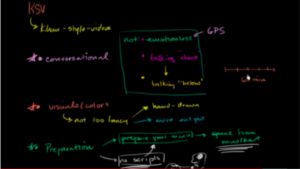I find that many of my students in grade six come to me with very little confidence in their math, and this hampers their progress when we move on to newer or extended concepts. For example, I teach multi-digit multiplication, sometimes up to four digits by four digits. In order to do this, and to make it become a transferable skill, I show them a method of ordering the calculations that creates a repeatable and linear process that can be applied to any number of digits.
This concept, although straightforward, can seem new to the students, and mastery is not something that comes easily. Video could support this (and other) outcome by using either a Udacity-Style Tablet capture, or a Khan -Style Tablet Capture, which would show the mathematical progression graphically, using the dynamic drawing principle. However, I can see this being even more effective by incorporating a hybrid method along with a Talking Head, to incorporate the gaze guidance principle, as referenced in Mayer et al (2020), and to keep the continuity of teacher presence on screen. I am intrigued by the idea of the RE:call Live Lecture Capture, as it would allow student viewers to benefit from the conversations and general queries that occur naturally during student/teacher interactions. Of course, my capture would not be a full lecture hall, but rather something much more intimate, as if it were a conversation rather than a dissemination.
With that in mind, I recognize the importance of keeping these pieces short; when I was making news broadcasts, we were told to keep them at 90 seconds, the optimal time a person can maintain focus. “Lesson content should be carefully planned and segmented into more manageable sections… (‘Chunking’) can lead to better understanding and retention” (Guo et al., 2014, as cited in Woolfit, 2015, p. 24).
References
Mayer, R. E., Fiorella, L., & Stull, A. (2020). Five Ways to Increase the Effectiveness of Instructional Video. Educational Technology Research and Development, 68(3), 837–852.
https://link.springer.com/article/10.1007/s11423-020-09749-6
Woolfit, Z. (2015). The effective use of video in higher education (Rep.), 10-38. Retrieved October 2, 2018, from https://www.inholland.nl/media/10230/the-effective-use-of-video-in-higher-education-woolfitt-october-2015.pdf



Leave a Reply
You must be logged in to post a comment.